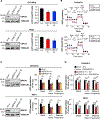BRCA1 Deficiency Upregulates NNMT, Which Reprograms Metabolism and Sensitizes Ovarian Cancer Cells to Mitochondrial Metabolic Targeting Agents
- PMID: 31619387
- PMCID: PMC6891213
- DOI: 10.1158/0008-5472.CAN-19-1405
BRCA1 Deficiency Upregulates NNMT, Which Reprograms Metabolism and Sensitizes Ovarian Cancer Cells to Mitochondrial Metabolic Targeting Agents
Abstract
BRCA1 plays a key role in homologous recombination (HR) DNA repair. Accordingly, changes that downregulate BRCA1, including BRCA1 mutations and reduced BRCA1 transcription, due to promoter hypermethylation or loss of the BRCA1 transcriptional regulator CDK12, disrupt HR in multiple cancers. In addition, BRCA1 has also been implicated in the regulation of metabolism. Here, we show that reducing BRCA1 expression, either by CDK12 or BRCA1 depletion, led to metabolic reprogramming of ovarian cancer cells, causing decreased mitochondrial respiration and reduced ATP levels. BRCA1 depletion drove this reprogramming by upregulating nicotinamide N-methyltransferase (NNMT). Notably, the metabolic alterations caused by BRCA1 depletion and NNMT upregulation sensitized ovarian cancer cells to agents that inhibit mitochondrial metabolism (VLX600 and tigecycline) and to agents that inhibit glucose import (WZB117). These observations suggest that inhibition of energy metabolism may be a potential strategy to selectively target BRCA1-deficient high-grade serous ovarian cancer, which is characterized by frequent BRCA1 loss and NNMT overexpression. SIGNIFICANCE: Loss of BRCA1 reprograms metabolism, creating a therapeutically targetable vulnerability in ovarian cancer.
©2019 American Association for Cancer Research.
Conflict of interest statement
Figures




References
-
- Lord CJ, Ashworth A. BRCAness revisited. Nat Rev Cancer 2016;16:110–20 - PubMed
Publication types
MeSH terms
Substances
Grants and funding
LinkOut - more resources
Full Text Sources
Other Literature Sources
Medical
Molecular Biology Databases
Miscellaneous

